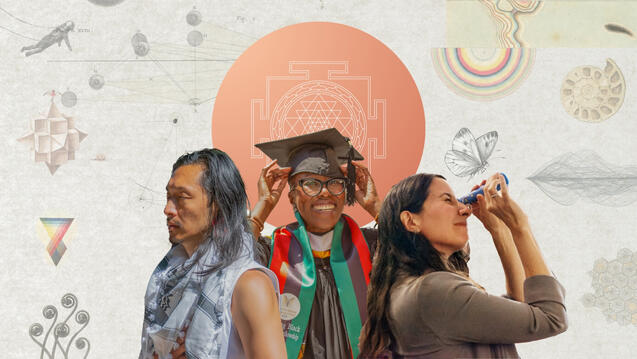At each CIIS Open House event, a community panel of faculty and alumni discusses what drew them to CIIS and their experiences at the University.

In Conversation with Debashish Banerji
Banerji and Craig Chalquist discuss his new book, Meditations on the Isa Upanishads: Tracing the Philosophical Vision of Sri Aurobindo
In his book, Meditations on the Isa Upanishads: Tracing the Philosophical Vision of Sri Aurobindo, chair of the East-West Psychology program Debashish Banerji, explores the Isha Upanishad. The Upanishads are early Indian wisdom texts that represent a foundation for Indian philosophies. Using complex linguistic devices such as puzzles, paradoxes, metaphors, dramatic personae, and word-play, they force an engagement of consciousness.
Banerji has been drawn to the study of the Upanishads as a quintessential mode of Indian philosophical thinking since 2000. He has been engaging with the philosophy of Sri Aurobindo since the 1990s and was intrigued by the Isha Upanishad, since Sri Aurobindo has written his own commentary on it. This interest was amplified by the fact that the Isha Upanishad relates to a particularly postmodern problem, that of homogenizing unifications vs. relativistic fragmentation. This is a social, cultural, and political problem of our times.
Drawing on this commentary and the larger body of Sri Aurobindo's works, Banerji's book presents four meditations on the Isha Upanishad. In the spirit of the Upanishads, these meditations are both presentations and contemplations, meant to aid subjective orientation and alignment to its central message. At the same time, they trace the philosophical vision of Sri Aurobindo.
The book is published by Maha Bodhi Book Publishers, one of the major Indological publishing houses of India with a history going back to the early 20th century. It will be released in January 2020 and will be available in bookstores and on Amazon by February. Advance copies may be available by writing to Banerji at dbanerji@ciis.edu.
What are the Upanishads?
Upanishads literally means “to sit close” and these early Indian wisdom texts that span about six centuries starting from about 8th c. BCE, represent an intimate pedagogical environment, where students lived with their teacher in a learning space, and sought to formulate philosophical problems of becoming and solve them through meditation, yoga practice, and experimentation. They may be thought of as a reform movement reacting to the mediated rituals of the Vedas, India’s earliest spiritual texts, holding out instead, unmediated access to the experiences of Truth.
The fundamental principle they taught was that reality has radically infinite potential and that anybody could know this by experience, because it was conscious and had individualized itself as the true self of all individuals. The absolute conscious reality is called Brahman and its individualized presence in each individual is called atman in the Upanishads.
What is the Isha Upanishad and what makes it unique?
The Isha Upanishad is a middle-period text, composed when the founding ideas of the Upanishads were well-developed and more specialized problems could be tackled. Early Upanishads were written in prose but the Isha is written in verse couplets of a lapidary precision and economy. It presents its ideas in a highly condensed form of only 18 profound contemplative couplets.
It deals with the problem of the One and the Many, which was also a key concern of early Greek philosophy. One way to think of it is as the problem of monism or monotheism against pluralism or polytheism. Earlier Upanishads stated that though we normally experience a plural and dualistic world, it is possible to transcend this condition and experience a single unitary consciousness, Brahman.
The Isha asserts that each of these experiences, that of the many and that of the one, experienced exclusively, is an entry into darkness; and enjoins the knowledge of both together as one experience.
How is Sri Aurobindo’s interpretation of the Isha Upanishad different from other interpretations?
Sri Aurobindo identifies the problem posed by the Upanishad as a fundamental problem of the Mind. The fundamental law by which the mind operates is the law of the excluded middle. This means that if some X is asserted as true, not-X cannot be true.
For him, the solution to the Isha Upanishad’s problem lies in finding a kind of operational consciousness that exceeds the law of the mind, and can experience unity, plurality, and duality simultaneously. He calls this consciousness supramental. He also calls it integral consciousness, from which the “integral” in CIIS is derived.
Does the Isha Upanishad have any relevance to our time?
If we take the Isha Upanishad as articulating the problem of the mind in holding opposites together, this is also a major problem of our times. As beings who strongly experience our separateness from others, we have a natural tendency to exclude or dominate others or to flatten diversity to some kind of oneness. Yet we cannot reduce radical plurality to one without subordinating and/or excluding it. Our idea of the one cannot but be someone, which denies all those who don’t fit its boundaries. Politically, this is another name for fascism. The rise of postmodern philosophies in our times is largely an attempt to counter this trend by preserving plurality against attempts at homogenizing or monopolizing it.
To take one example, Jacques Derrida’s deconstruction exposes the surreptitious politics at work in our social attitudes, where accepted norms often imply the subordination and concealment of their opposites. Deconstruction is a practice that tries to dislodge such privileges and bring opposites into equal visibility. Such practices help us to hold seeming contradictions together in our minds. Derrida also points to contradictions which are impossibilities or dead ends.
He calls them aporia, which are paradoxes that have no mental solution. Accepting them for what they are the mind falls silent and seeks an experience that transcends it. This may be an internal state or an external event, almost like a miracle or intervention from “beyond.” Derrida sees this as the “true future” (l’avenir), which cannot be predicted.
The Isha Upanishad tackles this problem of mental contradictions in its own way. It uses linguistic devices of contemplation, to bring home the non-ordinary experiences it refers to. This leads to a contemplative philosophy, or philosophy as praxis, which we sorely need today to overcome the masculinist strait-jack of an objectifying logic.
What is posthumanism, and why would it value the Upanishads?
Today, we increasingly realize that what we have assumed as the boundaries of the human are being rendered hazy by technology. But this transhuman transformation says little about our subjectivity or the capacities of inner consciousness.
On the other hand, since the 1960s, new philosophies such as existentialism or the philosophies of becoming, like that of Henri Bergson or Gilles Deleuze, have refused to take human consciousness, as we know it now, to be determined. Partly influenced by Nietzsche, who dreamed of the over human as a self-exceeding of the human, several of these philosophers believe that humans should formulate goals of becoming and attempt to achieve these through experiments of consciousness. One could say this is also the place of philosophy in the yoga traditions of India.
I would further say that this is quite consonant with how we approach consciousness in the East-West Psychology department at CIIS, and particularly so in my classes on Yoga Psychology or the Upanishads. Sri Aurobindo’s interpretation of the Isha Upanishad sees it as a text which promotes this kind of philosophical praxis. It shows how the Isha is calling for a state of consciousness that is not bound by the limits of the mind, yet that does not lose itself in some trance of samadhi and can live a fully creative life on earth. This is one way of understanding the posthuman as the contemporary need of our times.
Related Academic Programs
Related News
Zara Zimbardo and Lily Stone collaborated on the new album Marsification: A tale of planetary grief, featured on Radio 4’s Short Cuts.
New works from CIIS Professor of Clinical Psychology on the Psychological Potency of Dreams



